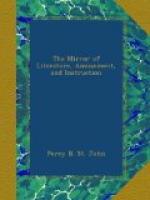“The circumstance was immediately descried from the shore, and a host of boats, amounting to 30 or 40, and armed with every species of weapon, set off to join the others in pursuit. The chase soon became one of bustle and anxiety on the part both of man and fish. The boats arranged themselves in the form of a crescent, in the fold of which the whales were collected, and where they had to encounter incessant showers of stones, splashing of oars, with frequent gashes from a harpoon or spear, while the din created by the shouts of the boats’ crews and the multitude on shore, was tremendous. On more than one occasion, however, the floating phalanx was broken, and it required the greatest activity and tact ere the breach could be repaired and possession of the fugitives regained. The shore was neared by degrees, the boats advancing and retreating by turns, till at length they succeeded in driving the captive monsters on a beach opposite to the town, and within a few yards of it. The gambols of the whales were now highly diverting, and, except when a fish became unmanageable and enraged while the harpoon was fixed, or the noose of a rope pulled tight round its tail, they were not at all dangerous to be approached. In the course of a few hours the capture was complete, the shore was strewed with their dead carcases, while the sea presented a bloody and troubled aspect, giving evident proofs that it was with no small effort they were subdued. For fear of contagion, the whole fish amounting to ninety-eight, some of them very large, were immediately towed to a spot distant from the town, where they were on Thursday sold by public roup, the proceeds to be divided among the captors. An annual visit is generally paid by the whales to the Lewis coast, and besides being profitable when caught, they generally furnish a source of considerable amusement. On the present occasion, the whole inhabitants of the place, male and female, repaired to the beach, opposite to the scene of slaughter, where they evidently were delighted spectators, and occasionally gave assistance. A young sailor received a stroke from the tail of one of the largest fish, which nearly killed him.”
* * * * *
AUDUBON.
The Philadelphia journals communicate some particulars of the journey of this enterprising naturalist into E. Florida. He has discovered, shot, and drawn a new Ibis, which he has named Tantalus fuscus. In a letter, he says
“I have discovered three different new species of Heath, one bearing a yellow blossom, the two others a red and purple one;—also, a beautiful new Kalmia, and several extraordinary parasitical plants, bearing some resemblance to the pineapple plant, growing on the eastern side of the cyprus tree in swamps, about 6 or 10 feet above the water.
“During my late excursion I almost became an amphibious being—spending the most of my days in the water, and by night pitching my tent on the barren sands. Whilst I remained at Spring Garden, the alligators were yet in full life; the white-headed eagles setting; the smaller resident birds paring; and strange to say, the warblers which migrate, moving easterly every warm day, and returning every cold day, a curious circumstance, tending to illustrate certain principles in natural economy.”




